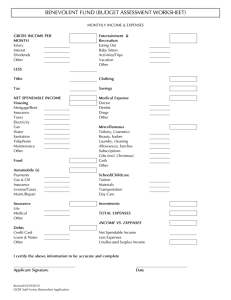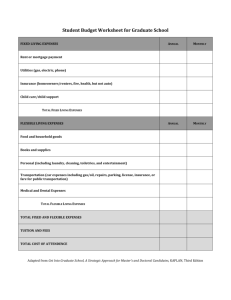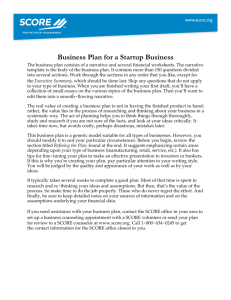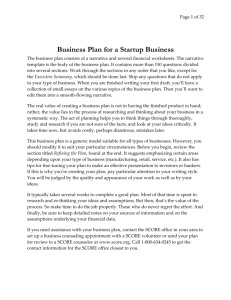Million Makers Business Plan Guidance
advertisement
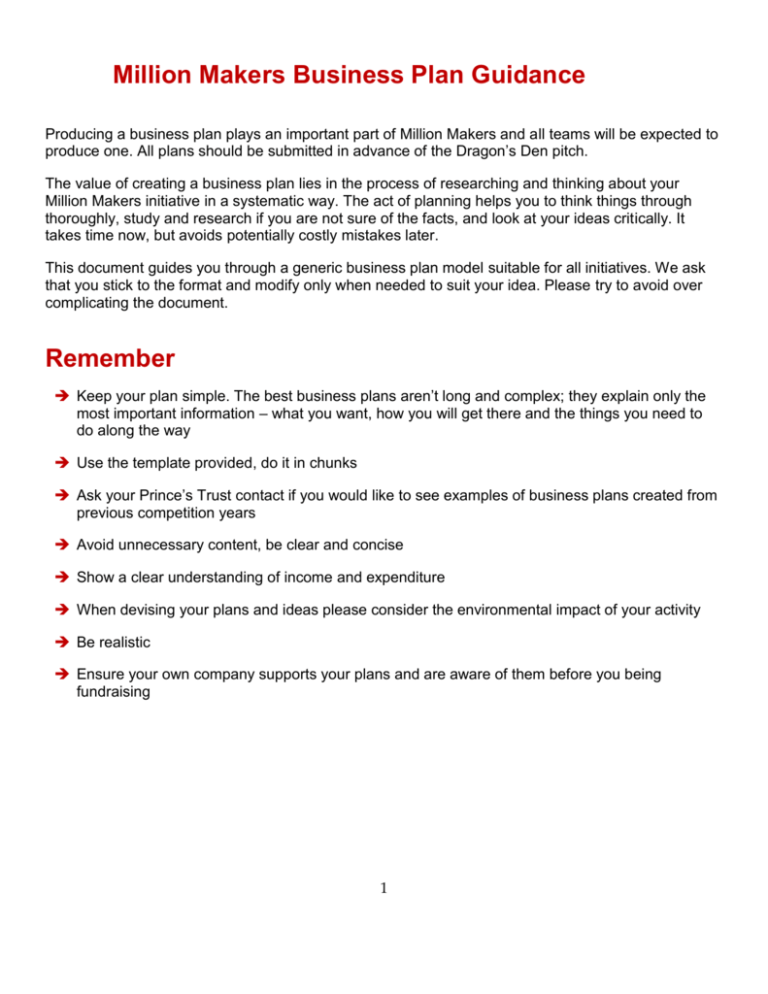
Million Makers Business Plan Guidance Producing a business plan plays an important part of Million Makers and all teams will be expected to produce one. All plans should be submitted in advance of the Dragon’s Den pitch. The value of creating a business plan lies in the process of researching and thinking about your Million Makers initiative in a systematic way. The act of planning helps you to think things through thoroughly, study and research if you are not sure of the facts, and look at your ideas critically. It takes time now, but avoids potentially costly mistakes later. This document guides you through a generic business plan model suitable for all initiatives. We ask that you stick to the format and modify only when needed to suit your idea. Please try to avoid over complicating the document. Remember Keep your plan simple. The best business plans aren’t long and complex; they explain only the most important information – what you want, how you will get there and the things you need to do along the way Use the template provided, do it in chunks Ask your Prince’s Trust contact if you would like to see examples of business plans created from previous competition years Avoid unnecessary content, be clear and concise Show a clear understanding of income and expenditure When devising your plans and ideas please consider the environmental impact of your activity Be realistic Ensure your own company supports your plans and are aware of them before you being fundraising 1 Contents Please make sure your business plan also contains a table of contents 1. Executive Summary……… .................................................................................. 1.1Summary 1.2 Mission Statement 2. 3 3 Team Background ................................................................................................ 2.1 Team Goals and objectives 2.2 Team Members 2.3 Team Advisor 3. 4 4 4 4 Products and Services ......................................................................................... 3.1 Product 1 3.2 Product 2 3.3 Product 3 4. 3 5 5 5 5 Marketing Plan ..................................................................................................... 4.1 Market Research - Why 4.2 Market Research - How 4.3 Target Market 4.4 Competition 4.5 Pricing 4.6 Distribution Channels 4.7 Promotion 4.8 Promotion Budget 4.9 Marketing plan chart 6 6 6 6 6 7 7 7 7 7 5. Startup Expenses and Capitalization ................................................................... 8 6. Financial Plan ...................................................................................................... 9 6.1 Six Month Profit and Loss Projection 6.2 Projected Cash Flow 2 9 10 1. Executive Summary Write this section last. We suggest writing no more than a page; the purpose is to give someone an overview of your business plan. When drafting it think about whether someone could read this in isolation and have enough information to understand what you are trying to achieve. 1.1 Summary Explain the fundamentals of the proposed business: What will your product be? Who will your customers be? Who are the owners? What do you think the future holds for your business and your industry? Make it enthusiastic, professional, complete, and concise. If applying for seed funding, state clearly how much you want, precisely how you are going to use it, and how the money will make your business more profitable, thereby ensuring repayment. 1.2 Mission Statement - Points 1.2 and 1.3 are not compulsory but may help give your team a focus. In 30 words or fewer, explain your team’s reason for being and your guiding principles. E.g. Team X mission statement is: To raise funds for The Prince’s Trust whilst furthering our professional development 1.3 Values The qualitative goals your team strives to achieve in all its activities E.g. Creativity, integrity, collaboration, development, commitment, inspiration, equality 3 2. Team background 2.1 Team Goals and Objectives Goals are destinations—where you want your team to be. Objectives are progress markers along the way to goal achievement. For example, a goal might be to have a successful initiative that wins Million Makers! Objectives might be your sales targets and some specific measures of success. 2.2 Team Members Names of all team members and roles within the team, include contact details 2.3 Team Advisors Names of your Prince’s Trust contact and any internal or external mentors 4 3. Products and Services 3.1 Product 1 Describe in depth your product, service or activity What’s the pricing of your product or service What/who is the target market 3.2 Product 2 3.3 Product 3 And so on… 5 4. Marketing Plan 4.1 Market research - Why? No matter how good your product and your service, the venture cannot succeed without effective marketing. This is not only marketing the product but also understanding your target market and the need for the product or service. This begins with careful research. It is very dangerous to assume that you already know about your intended market. You need to do market research to develop the product/service and make sure you’re on track. 4.2 Market research - How? For the purposes of this competition, the most effective form of market research is Primary Research; that is, gathering your own data. For example, you could do your own traffic count at a proposed location; do surveys or focus-group interviews to learn about consumer preferences; and check out whether your initiative (or something similar) has been tried successfully in your company before. You may also take into consideration lessons learnt from previous Million Makers teams from your company. 4.3 Target Market In your marketing plan, be as specific as possible; give statistics, numbers, and sources. The marketing plan will be the basis, later on, of the all-important sales projection. Identify your targeted customers, their characteristics, and their geographic locations, otherwise known as their demographics. The more specific you can be the better. What will prompts them to spend and from who. The description will be completely different depending on whether you plan to sell to other businesses or directly to individuals. If you sell a consumer product, but sell it through a channel of distributors, wholesalers, and retailers, you must carefully analyze both the end consumer and the middleman businesses to which you sell. You may have more than one customer group. Identify the most important groups. Then, for each customer group, construct what is called a demographic profile: Age; Gender; Location; Income level; Social class and occupation; Education For business customers, the demographic factors might be: Industry (or portion of an industry); Location; Size of firm; Quality, technology, and price preferences 4.4 Competition What products and services will be in competition with you? You may want to create a table for this. How will your products or services compare with the competition? You may want to conduct a SWOT analysis of your main products/services– strengths, weaknesses, opportunities and threats 6 What is your USP – unique selling point? Now, write a short paragraph stating your competitive advantages and disadvantages. 4.5 Pricing Explain your method or methods of setting prices. Does your pricing strategy fit with what was revealed in your competitive analysis? Compare your prices with those of the competition. Are they higher, lower, the same? Why? How important is price as a competitive factor? Do your intended customers really make their purchase decisions mostly on price? 4.6 Distribution Channels How do you plan to sell your products or services? Also consider how you will collect payment, this is a very important point to consider. 4.7 Promotion How will you get the word out to your customers? Advertising: What media, why, and how often? Have you identified low-cost methods to get the most out of your seed funding investment? Will you use methods other than paid advertising, such as dealer incentives, word of mouth (how will you stimulate it?), and network of friends or professionals? What image do you want to project? How do you want customers to see you? 4.8 Promotional Budget How much will you spend on the items listed above before startup? (These numbers will go into your startup budget.) 4.9 Marketing plan chart Make sure this is in chronological order Marketing activity date Marketing activity Number targeted Cost Example August 12th Online fundraising page shared with friends and family 150 £0 August 15th Advert in local newspaper 7 30,000 £600 5. Startup Expenses and Capitalization You will have many startup expenses before you even begin your initiative. It’s important to estimate these expenses accurately so that you can pitch for your seed funding effectively. The more thorough your research and planning efforts, the less chance that you will leave out important expenses or underestimate them. There are two ways to make allowances for surprise expenses. The first is to add a little “padding” to each item in the budget. The problem with that approach, however, is that it destroys the accuracy of your carefully wrought plan. The second approach is to add a separate line item, called contingencies, to account for the unforeseeable. This is the approach we recommend. Explain your research and how you arrived at your forecasts of expenses. 8 6. Financial Plan The financial plan consists of a 6 month profit and loss projection and cash-flow projection. The process of thinking through the financial plan will improve your insight into the financial workings of your team. Remember: You should not re-invest more than 50% of your funds without having this signed off by your Prince’s Trust contact. 6.1 Six Month Profit and Loss Projection This is where you put your ideas together in numbers and get an idea of what it will take to make a profit and be successful. Your sales projections will come from a sales forecast in which you forecast sales, cost of goods/services sold, expenses, and profit month-by-month for the 6 months of the challenge. Profit projections should be accompanied by a narrative explaining the major assumptions used to estimate company income and expenses. Income Notes* £ Auction 1 4,000 Car wash 2 500 Total 4500 Example *Notes – detail as to how income figure achieved 1. 5 lots estimated to raise £4000 based on auctioneer estimation 2. 100 cars washed for £5 Expenditure Notes* £ Auction 3 250 Car wash 4 50 Total 300 Example *Notes – detail as to how expenditure figure is achieved 3. Auctioneer costs 4. Costs of shampoo and equipment for 100 cars Total Profit/Loss - Income minus expenditure; Example: 4500-300= 4200 9 6.2 Projected Cash Flow If the profit projection is the heart of your business plan, cash flow is the blood. Every part of your business plan is important, but none of it means a thing if you run out of cash. The point of this is to plan how much you need before startup, for preliminary and operating expenses. You should keep updating it and using it afterward. It will enable you to foresee shortages in time to do something about them—for example by cutting out expenses. There is no great trick to preparing it. The cash-flow projection is simply an outline of how you see the income and outgoings from your account looking. For each item, determine when you expect to receive cash and when you will have to make a payment. Please note that income received via online payment sites such as JustGiving will be paid directly to The Prince’s Trust and therefore cannot be reinvested into your business plan. You may want to record this as separate to the rest of your income. Capital In August Auction 4000 September October November December January Total 4000 Raffle 500 500 Car wash 500 500 Monthly goods sale 100 100 100 100 100 100 600 Total 4100 100 600 100 600 100 5600 Capital Out August September October Auction 250 Raffle November December January 250 50 50 Car wash 50 Monthly goods sale 200 Total 450 Total 50 200 50 50 10 550



